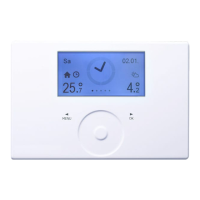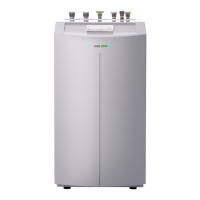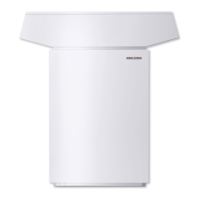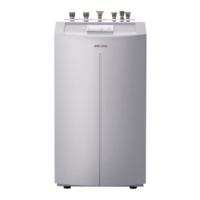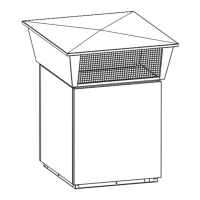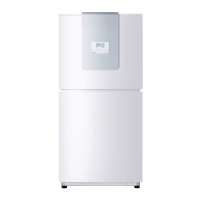38 | WPM 3 www.stiebel-eltron.com
INSTALLATION
Commissioning
Defrost mode heat pump type 2/2*
Once the pressure cell has responded in heating or DHW mode,
the heat pump immediately switches into defrost mode.
Note the special feature with the buffer operation OFF setting and
subsequent DHW demand. Once the pressure cell has responded,
the heat pump switches into forced heating mode for 5 minutes.
The condenser temperatures (frost protection sensor) are com-
pared with the return temperature until defrosting is initialised.
If the differential is greater than 25 K, the heat pump is switched
off with a DEFROST fault. In addition, the condenser (frost pro-
tection sensor) is monitored in the DEFROST operating mode. The
DEFROST fault is displayed at temperatures < 10 °C.
Fault logic: 5 faults in 2 hours of compressor runtime will cause
the heat pump to interlock.
Defrost mode heat pump type 3/3*
As soon as defrosting has been initialised in the refrigerant circuit
by assessing the process value constellation, or a reference de-
frost is required, the heat pump switches immediately into defrost
mode.
The compressor is switched off for a limited time, before restarting
in defrost mode.
When the heat pump is in DEFROST mode, the electric booster
stages (NHZ) switch on if the temperature falls below 15 °C at the
condenser (frost protection sensor) or the heat pump flow.
In addition, the following are monitored during defrost:
- Frost protection temperature or
- Flow temperature or
- Flow rate limit
At temperatures of < 10°C or when the flow rate limit is not
reached, the fault DEFROSTis displayed.
Fault logic: 5 faults in 2 hours of compressor runtime will cause
the heat pump to interlock.
Defrost mode heat pump type 4/4*
Once the pressure cell or pressure sensor has responded in heat-
ing or DHW mode, the heat pump immediately switches into de-
frost mode.
When the heat pump is in DEFROST mode, the electric booster
stages (NHZ) switch on if the temperature falls below 15 °C at the
condenser (frost protection sensor) or the heat pump flow.
In addition, the following are monitored during defrost:
- Frost protection temperature or
- Flow temperature or
- Flow rate limit
At temperatures of < 10°C or when the flow rate limit is not
reached, the fault DEFROSTis displayed.
Fault logic: 5 faults in 24 hours of compressor runtime will cause
the heat pump to interlock.
Defrost mode for HP type 5/5*
As soon as defrosting has been initialised in the refrigerant circuit
by assessing the process value constellation, or a reference de-
frost is required, the heat pump switches immediately into defrost
mode.
At an outside temperature above 5 °C the compressor speed is
reduced such that the evaporation temperature is > 0°C. If this
defrosting measure is unsuccessful after a runtime of 30min, de-
frosting through refrigerant circuit reversal is initiated.
Below 5 °C outside temperature, the compressor is switched off
for a limited time before restarting in defrost mode.
When the heat pump is in DEFROST operating mode, the electric
booster stages (NHZ) switch on if the temperature is < 15°C at the
condenser (frost protection sensor) or at the heat pump flow. In
addition, the following are monitored during defrosting:
- Flow temperature or
- Flow rate limit
At temperatures < 10°C during defrosting or < 18°C within 30sec-
onds before defrosting, fault DEFROST is displayed.
Fault logic: 5 faults in 24 hours of compressor runtime will cause
the heat pump to interlock.
Maximum defrost time
The maximum defrost time for all heat pump types is 20 min-
utes. Defrosting is terminated after the maximum defrost time has
elapsed. The heat pumps are then forced to operate in heating
mode for 20 minutes. Only then can a new defrost process be
initiated.
IDLE TIME
After a heat pump has been shut down, an idle time is set to
protect the compressor. The default idle time of 10 or 20 minutes
(according to heat pump type) should normally not be reduced.
Where a reduction is required because of adjustments or repair
work, reset the idle time back to 10 or 20 minutes after completing
the necessary work.
MAXIMUM CURRENT
This parameter applies only to heat pumps with variable output.
This parameter can be used to limit the maximum power con-
sumed by the heat pump to match it to the power supply conditions
at the installation site.
It should, however, be noted that high flow temperatures or low
outside temperatures will cause the heating output to drop.
MINIMUM RUNTIME
Setting range 0 to 30 minutes
Each time the compressor is switched on, a countdown starts
using the selected time (in minutes). The controller can only stop
the compressor after this time has elapsed, i.e. controller shut-
down can be delayed. One exception is a response by the temper-
ature limiter or pressure switch, which results in an immediate
shutdown.
HEATING SYSTEM SIZING
The heat demand for the house is set here, taking into consider-
ation the lowest regional temperatures (for example 10kW heat
demand at -14°C outside temperature). During operation, the
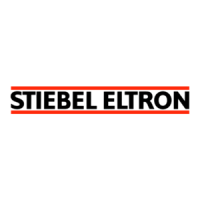
